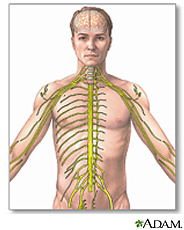 |
 |
 |
||
    |
||||
|
||||
|
Other Health Topics:
Charcot-Marie-Tooth Disease
Also called: Hereditary motor and sensory neuropathy, Peroneal muscular atrophy
Charcot-Marie-Tooth disease (CMT) is a group of genetic nerve disorders. It is named after the three doctors who first identified it. In the United States, CMT affects about 1 in 3,300 people. CMT affects your peripheral nerves. Peripheral nerves carry movement and sensation signals between the brain and spinal cord and the rest of the body. Symptoms usually start around the teen years. Foot problems such as high arches or hammertoes can be early symptoms. As CMT progresses, your lower legs may weaken. Later, your hands may also become weak. There is no cure. The disease can be so mild you don't realize you have it or severe enough to make you weak. Many people with CMT lead active lives and have a normal life span. Physical therapy, occupational therapy, braces and other devices and sometimes surgery can help you cope. Genetics Home Reference
Start Here
|
| Home | Health Topics | Drugs & Supplements | Encyclopedia | Dictionary | News | Directories | Other Resources | |
| Disclaimers | Copyright | Privacy | Accessibility | Quality Guidelines U.S. National Library of Medicine, 8600 Rockville Pike, Bethesda, MD 20894 National Institutes of Health | Department of Health & Human Services |
Date last updated: 02 March 2009 Topic last reviewed: 10 March 2009 |


